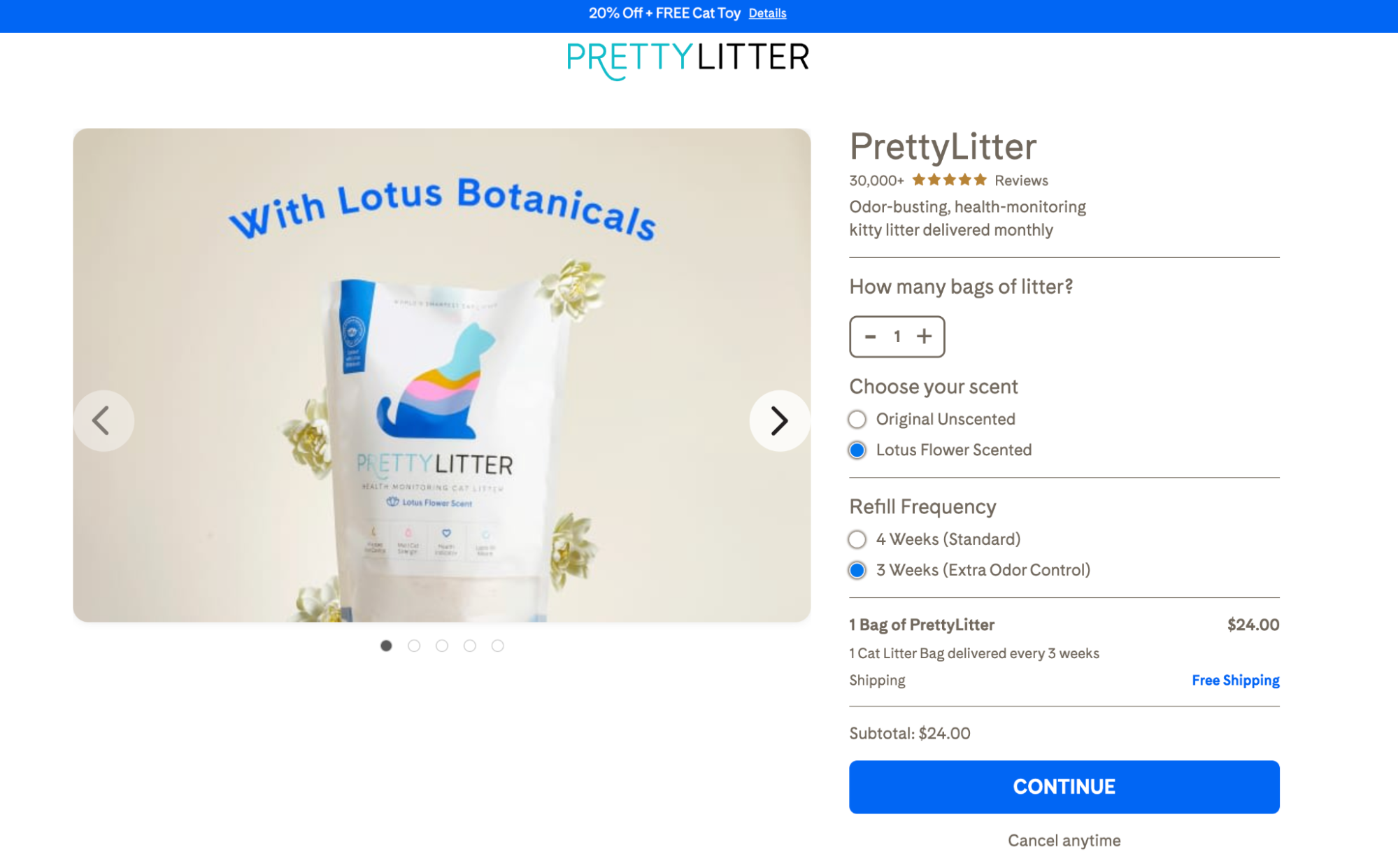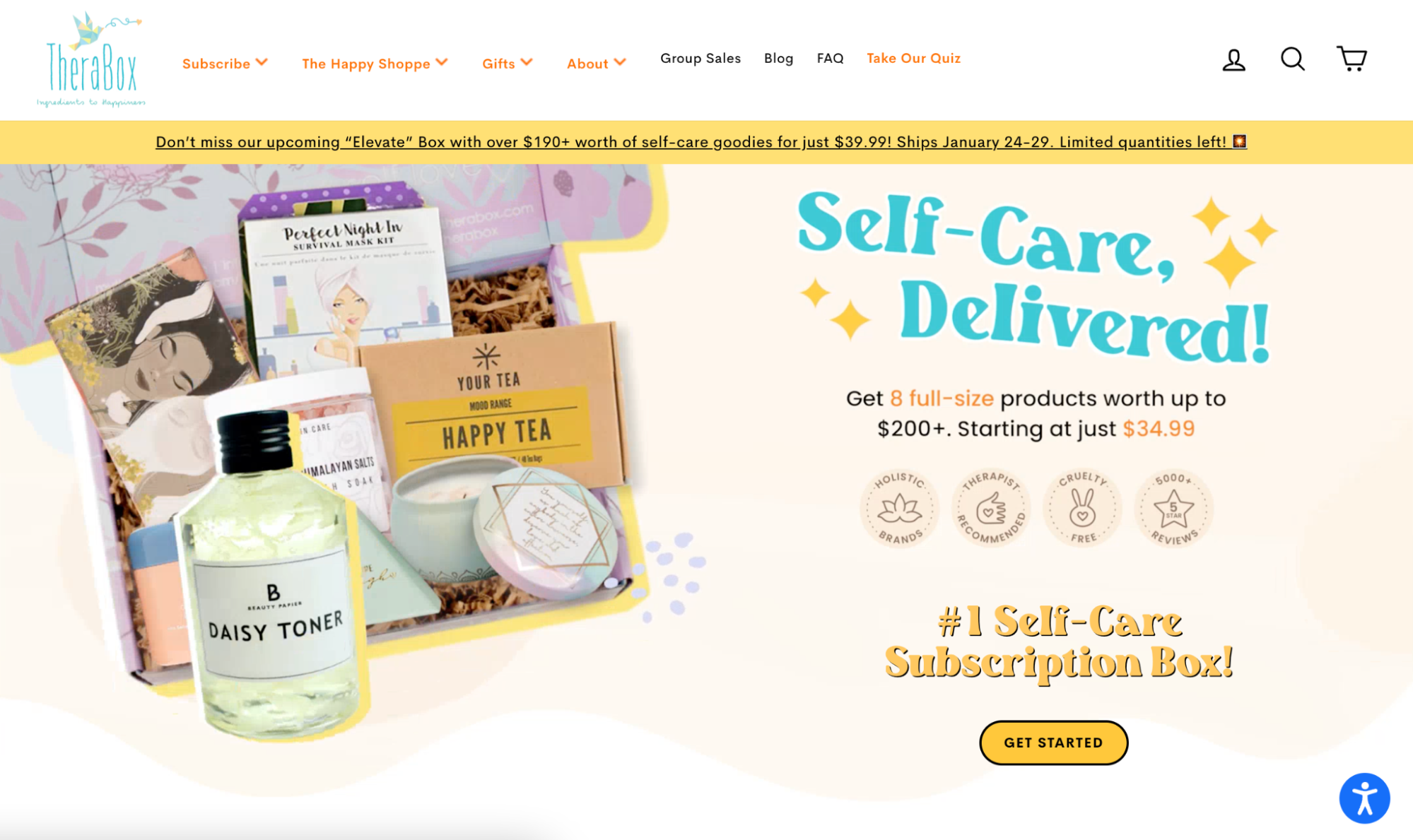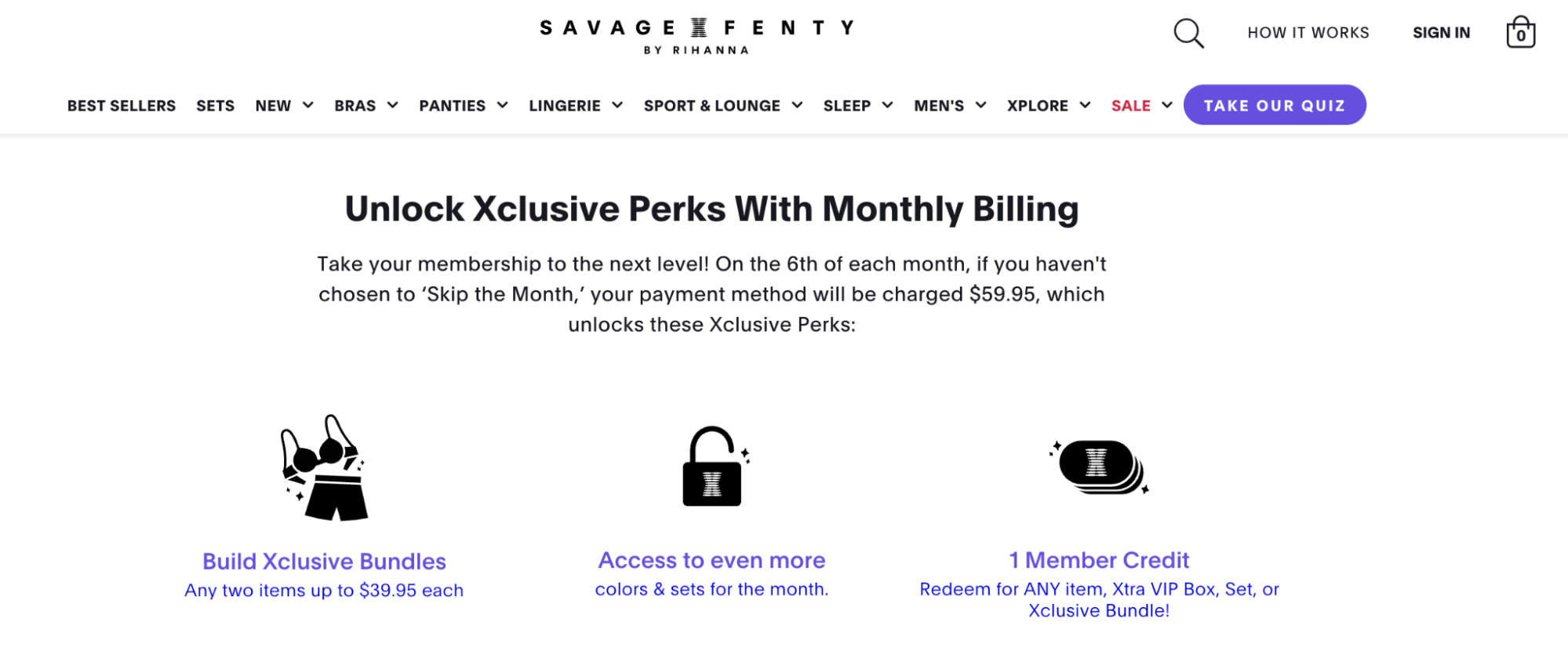The age of the ecommerce subscriptions has arrived in a big way.
It’s a primary business model for businesses like Netflix and Spotify, which offer a Software-as-a-Service, or SaaS model, and now subscriptions have begun to spread to other industries such as fashion and beauty.
For example, Birchbox sends its subscribers a selection of cosmetics, skincare products, perfumes, and organic products monthly. And men’s lifestyle brand Manscaped sells grooming replenishments via subscription. Done right, ecommerce subscriptions can be a powerful driver of growth for your business.
At its basic form, a subscription business model is one that charges customers a recurring fee—usually monthly or yearly—for access to a product or service.
But on a deeper level, ecommerce subscriptions are about strong customer relationships. Subscriptions turn customers, who already see the value your company provides, into loyal followers who become reliable sources of recurring revenue. In fact, the longer a customer uses your product or service, the more valuable they become to you. Plus, higher customer retention rates mean lower acquisition costs in the long term.
In this article, you’ll learn the value of subscriptions from a revenue perspective, the outlook for the subscriptions industry as a whole, and how you can turn any product or service into a subscription.
What are ecommerce subscriptions?
Ecommerce subscriptions are a business model that allows customers to continuously receive a product or service for a period of time. Subscriptions can increase an online store's revenue and customer lifetime value.
Types of ecommerce subscriptions
Replenishment
A replenishment ecommerce subscription is most common for businesses that sell commodities, like personal care items, groceries, or pet supplies. The goal is to provide a convenient solution for customers to receive items at set intervals, so they don’t have to reorder everytime.
Pretty Litter, for example, lets you choose the frequency of your refill on its product page. You could receive a new cat litter bag every three or four weeks, and can cancel anytime.

Curation
A curation subscription gives you a personalized experience or product based on what you like. It's usually based on your taste in fashion, beauty, food, or books. The appeal is the surprise and discovery, since every delivery contains a different assortment of things.
For example, TheraBox, an award-winning subscription box, sends monthly curated boxes around self-care. After ordering a themed box, you could receive a ton of gifts ranging from toners to teas, creams, candles, and more. Each month is a new surprise.

Access
Customers get exclusive benefits like special discounts, members-only stuff, and early access to new stuff with access subscriptions. Companies use this model to build loyal customers by offering perks that aren't available to non-subscribers.
Savage X Fenty is a well-known subscription ecommerce service in this category. Members get access to special benefits like exclusive VIP bundles, new products, free returns, and content. All you have to do is spend a minimum of $50 per month with the store.

Benefits of ecommerce subscriptions
The good news for retailers looking at offering a subscription model is that business is booming. Projections suggest that by 2025 the global ecommerce subscription market will be worth $246.6 billion.
Hassle-free shopping experience
Consumer buying habits are trending toward hassle-free shopping experiences, free delivery, and instant gratification. The subscription model serves all those needs, providing value to the customer with low effort, and incredible growth opportunities for subscription-based businesses.
In many ways, it comes down to convenience. Gone are the days of running out of things and having to pop to the store last minute. Subscriptions are the ultimate example of “set it and forget it.” The customer makes the decision once when they sign up for the service, and then, like clockwork, they receive their goods or services without having to think about it again.
And with the added benefit of low cost or free shipping, it removes the hassle of having to make a trip out to get something—which is of huge benefit now during pandemic lockdowns and restrictions.
Predictable revenue and inventory management
Traditional online retail is based on ad hoc purchasing and total revenues, whereas subscription models rely on pre-planned purchasing and recurring revenue. The value of a subscription is in this recurring, predictable revenue.
This consistent, predictable revenue lets subscription-based companies order and manage inventory more efficiently. Understanding a customer’s lifetime value in a subscription business can help brands spend wisely on acquisition in slow-selling seasons. Given the closer, more targeted relationship you have with subscribers than with typical consumers, the most successful subscription businesses can see reduced churn rates in their customer base.
Reduced churn rates
Subscription businesses often experience lower churn rates due to a closer relationship with customers. As a benchmark, the average churn rate for B2C businesses is 6.77%. Voluntary churn can be caused by customer dissatisfaction, while involuntary churn points to payment issues.
Pricing also tends to be far more straightforward with subscription-based businesses, as stores focus on macro pricing with tiers, rather than individual prices on an array of products.
Higher repeat purchases
Ecommerce subscriptions likewise help brands increase repeat purchases since you don't have to win the business ad hoc every time if you have a loyal, subscribed customer base. You have a higher chance of selling to an existing customer versus selling to a new prospect.
Subscription-based business models enable companies to be heavily data-driven with customer targeting and acquisition, and pass the cost savings around distribution, marketing, and personalization on to their customers. The insights that subscription-based businesses have into their customer base create enhanced cross-selling and marketing opportunities that simply aren’t possible for typical retailers.
Higher company valuations
In addition, should you decide to sell your business, recurring revenue ultimately makes your company more valuable and attractive to investors or potential buyers.
The Subscription Economy Index (SEI), which tracks subscription businesses on the Zuora platform, reveals that subscription businesses grew revenues approximately 3.7 times faster than S&P 500 company revenues (17% versus 4.6%) and U.S. retail sales (18.2% versus 3.7%) from January 1, 2012 to December 31, 2022.
The key to subscription businesses is customer retention and customer lifetime value (LTV). That's why churn rate, rate of customer acquisition, and the cost of finding new customers are important metrics when you run a subscription business.
Challenges of ecommerce subscriptions
With all the good, there come some drawbacks to ecommerce subscriptions. Here are a few things to consider:
-
Managing churn: It's hard to keep customers on subscription models. Unlike traditional one-time purchases, subscription services rely on ongoing customer satisfaction and engagement. The challenge is to keep offering value that justifies recurring fees.
-
Balancing CLTV and acquisition costs: Not only must you attract customers, but also ensure they find enough value to continue their subscriptions. Subscriber-based businesses, like meal kit delivery services (think, HelloFresh), invest heavily in customer acquisition. If customers don’t stick around long enough to recoup these costs and make a profit, however, you’ll struggle to grow.
-
Subscription fatigue: Subscriptions seem everywhere now. From Disney+ to Adobe Creative Cloud, consumers are experiencing subscription fatigue, where customers get tired of managing subscriptions and don’t want to add new ones.
How to implement ecommerce subscriptions
Before packing your products into a subscription box, it’s important to understand the reasons why brands incorporate subscriptions into their existing products.
-
Differentiation: In a highly commoditized or saturated industry, like beauty, a subscription offering can set your brand apart and establishes you as a curator or influencer in your space
-
Segmentation: With more information on subscription customers than a typical checkout, there is greater opportunity for upsells or cross-sells as well as to “surprise and delight”
-
Stability: As subscriptions take root, you can more accurately predict inventory levels, reduce waste, and cultivate recurring revenue stream.
Customers don’t subscribe to products because they enjoy money exiting their bank accounts every month. So why do so many buyers subscribe to products?
-
Exploration: With so much choice online, many buyers see subscriptions as a simple way to “try something new” that’s highly personalized
-
Personalization: One of the main factors in the longevity of a subscription is increased personalization over time—this is something to keep in mind to minimize churn
-
Value: Overall price is not the key factor here, but rather value for money; as one of the key reasons why someone subscribes and churns, it’s important to manage expectations with your buyers
Ecommerce subscription platforms
Thinking about adding subscription billing to your revenue model? Here are some of the top Shopify Apps to add to your store:
-
Seal Subscriptions App: A subscription ecommerce platform known for its easy setup and user-friendly interface. With it, you can offer classic and prepaid subscriptions, free trials, tiered discounts, and a comprehensive set of tools for managing recurring revenue. Free for up to 150 monthly subscribers; paid plans range from $4.95 to $380 per month, with no transaction fees.
-
Appstle℠ Subscriptions App: Offers comprehensive subscription management functions, including customizable schedules and dashboards. This app includes regular and prepaid subscriptions, free trials, build-a-box options, loyalty features, and various integrations. Free for up to $500/month in subscription revenue; paid plans start at $10 per month.
-
Recharge Subscriptions: A popular subscription platform that Integrates smoothly with existing payment processors and offers robust order management tools. It also allows customers to manage subscriptions via customer portal and SMS. 30-day free trial available; paid plans start at $99 per month.
If your store is powered by Shopify, you can also build your own custom subscription management tool using Shopify’s new Subscription APIs and Product Subscription Extension.
Shopify’s suite of APIs and open-source templating language, Liquid, enable you to make Shopify work the way you need it to. Take a DIY approach and build in-house with your own developer team. Or, if you’d prefer, you can reach out to one of our Shopify Service Partners to help you plan a subscription strategy and develop a custom app to do what your brand needs.
Ecommerce subscription best practices
These days, you can turn any product or service into a subscription. While there have traditionally been subscription categories like home goods (e.g., razors or vitamins), apparel, food, or beauty products, today there are no rules—if you sell a product, you can make a successful entry with the available subscription ecommerce platforms.
Pretty Litter sells what it calls the world’s smartest kitty litter. While the brand’s subscription keeps tabs on a cat’s health by changing color, the company’s Head of Business Intelligence, Joe Barger, suggests what Pretty Litter really sells is convenience and peace of mind.
-
Convenience: No need to worry about when to refresh their litter
-
Peace of mind: Daily check that their feline friends are healthy
“There are millions of things on everyone’s minds these days,” Barger says. “We offer our customers fewer things to worry about when it comes to some of the most important aspects of their lives—their pets.”
Barger has agreed to share some of Pretty Litter’s most valuable insights to give other brands ideas to succeed with subscriptions.
Learn from power users
Pretty Litter has established a VIP hero group on Facebook, home to thousands of their top customers. The group not only allows Barger and his team to learn directly from power users by getting direct feedback, but it also gives the brand an opportunity to build brand ambassadors.
“Continuous adaptation is a key to success,” Barger says. “What works today may not work tomorrow and you need to always keep a pulse on what’s working or not and be ready to double down on wins while pulling back on poor-performing channels.”
Build a unique value proposition
Consumers haven’t been conditioned to think of kitty litter as an ecommerce subscription. But saving customers time and knowing the kitty litter that arrives automatically every month is helping them protect and care for their pets is a value proposition the brand built for maximum product “stickiness”.
“We have built a clear and unique value-add that addresses the convenience of a continuity model,” Barger says. ”Especially for a product that is needed on a consistent and ongoing basis.”
Personalization increases retention
Offering online subscriptions allows Pretty Litter to tailor branded communications with the customer. Customers can revisit the Pretty Litter site on their own convenience and learn about the benefits, as opposed to when they’re already in a rush at the grocery store.
Even more important, personalizing the subscription experience helps Pretty Litter retain more of its subscription customers. Instead of a one-size-fits-all offering, Pretty Litter offers customers flexibility and choice.
“It’s rare that there is one solution for everyone,” Barger says. “Offering customers the ability to build their own flexible plan is key to retaining your customers. If you’re going to introduce other products, make sure that they’re a relevant fit to your brand. A random product that doesn’t tie back to your core brand could do more harm than good.”
Monitor cash flow
With customer acquisition costs and churn relatively high, ecommerce subscriptions require more attention than other businesses might. Paying close attention to the financial details of your subscription business is key. Especially when you consider that consumers are being conditioned to expect more.
Customer expectations, according to Barger, are rising continuously due to Amazon’s fast and free shipping. While matching Amazon’s expedited shipping is expensive, subscription brands must simultaneously meet customer expectations while intelligently managing the company’s finances.
“Cash flow management is very important to ensure a healthy business,” Barger says. “Subscription KPIs are very different from traditional retail models. Make sure you have the budget and cash flow to spend on acquiring customers.”
And kitty litter isn’t the only non-traditional good that works under a subscription model. Subscriptions can also work for items that traditionally are not immediately replenished.
Read more
- Ecommerce Marketing Strategies: A Comprehensive Guide for Growth
- Scaling a Global Ecommerce Business: Three Keys from $100M+ Enterprises
- Hypefest 2018: O2O Examples from the Forefront of Marketing & Retail
- Is Your Agency 'The One'? An Inside Scoop on Finding a True Partnership
- Multi-Channel Customer Acquisition: 7 Tips from $3.7M+ in Ad Spend
- The 4 Words at the Root of All Meaningful Client-Agency Relationships
- Rethinking Retargeting: Finding the Line Between Stalking and Solving
- A Strategy for Human Resources in our Current Climate
- How 3 Brands Scaled Their Ecommerce Subscription Model 100-350%
- A Crisis Communications Plan for Brands
Ecommerce Subscriptions FAQ
What is the subscription revenue model in ecommerce?
Ecommerce subscription models involve customers paying recurring fees to receive products or services. Using this model, businesses receive consistent revenue by automating the purchase process and ensuring a steady supply of products or services for customers.
What are online subscriptions?
Online subscriptions are agreements where customers subscribe to receive products or services regularly, often via the company's online store or app. A variety of products and services can leverage the subscription-based business model, from digital content to physical goods such as meal kits and beauty products.
What is an example of a subscription product?
One example of a subscription product is a monthly beauty box that sends out a curated collection of skincare and cosmetics every month. You can offer samples or full-sized products in these boxes, and they can be customized to fit the customer's skin type or preferences.
How big is the subscription ecommerce market?
Subscription ecommerce businesses are on the rise. As of 2023, the subscription ecommerce market had reached approximately $193.6 billion. Looking ahead, it could reach $5,014.4 billion by 2032, according to projections from the IMARC group.
What are the best subscription ecommerce platforms?
-
Shopify
-
Adobe Commerce (formerly Magento)
-
BigCommerce
-
Square
-
Stripe




